XeonTheMGPony
International Hazard
    
Posts: 1641
Registered: 5-1-2016
Member Is Offline
Mood: No Mood
|
|
Distilation of gas to get petroleum Ether
https://en.wikipedia.org/wiki/Petroleum_ether
Petroleum ether is a handy solvent for certain tasks and can be used with energetics as a plastic solvent, or for certain plant oil extracts and
de-waxing of hexamine fuel pellets.
The trick is doing it safely. Recently I reconstituted my 500ml supply and thought I'd share my method.
Get a 1L flask and fill to just below center (The gas will expand considerably)
Set up a vigreux column size isn't so important but it will help, if you do not have one this will still be easily doable just longer as you
compensate by very gentle heating in a simple distillation mode
Use a vacuum take off adapter and run the tube to a fume hood or out a window, and set up a fan to draw air through the room and out the window as
well.
Ensure all joints are clipped and fully engaged, Now it is important to ensure every thing is ready, as once you start do not unplug, plug in, or use
any light switches once started! and DO NOT SMOKE!!!! while doing this!
Get your condenser water cooled with ice if using a recirculating system. You may wish to pre-cool your receiving flask (250ml) but I often just
accept the slight losage and let the condensate do that, but if you wish to avoid the fuming it will be to advantage to chill the storage bottle and
receiving flask.
Double check your apparatus, and start heat off very low, and slowly increase it till you see the solvent front creep up the column, depending on
season and room temp the first thing will be butane. I tend to set my heat source to 100c during the distillation, as the lighter fractions boil off
the temp will rise. As you'll notice my mantle is a 500ml sized one I like this as the 1L flask is air bathed, which works well for this distillation
as you can distill gas with out ever bringing it to an actual boil!
Once this reaches the top wrap your column in a towel or shirt what ever max temp it will every be at is 65c (I terminate mine at 61c).
End of crude run.
Second run, splitting fractions
Clean all gear, combine all crude runs if any previous ones where don.
Re-assemble and fill the 1l flask with crude, have two chilled bottles handy and attach your cooled 250ml receiving flask.
Add ice to your condenser water and start this, allow to cool.
Slowly start the heat on your distillation flask. run until the therm hits your cut off (I use 35c and down as fraction one, and 35c and up to 60 for
the second)
Swap flasks to your second and or third, do not boil to dryness.
I use the tailings in my Colman gas stove with some fresh gas, or mix with a bit of oil and paper pulp as a fire starting aid for the wood stove, but
you can use it for glue removal and or other solvent uses, the smell will permeate most plastic containers, so store tailings in a sealed metal can or
controlled burnt off.
Wikie cleaning procedure (I've never bothered as I mostly use it for de-waxing and such)
| Quote: |
Most of the unsaturated hydrocarbons may be removed by shaking two or three times with 10 % of the volume of concentrated sulfuric acid; vigorous
shaking is then continued with successive portions of a concentrated solution of potassium permanganate in 10 % sulfuric acid until the color of the
permanganate remains unchanged. The solvent is then thoroughly washed with sodium carbonate solution and then with water, dried over anhydrous calcium
chloride, and distilled. If required perfectly dry, it can be allowed to stand over sodium wire, or calcium hydride.[6] |
Some point I'll research the claims and may make a bottle of "lab grade" petroleum ether but as is I find that the above makes a useful solvent for
most things with few issues encountered.
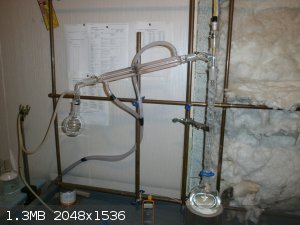 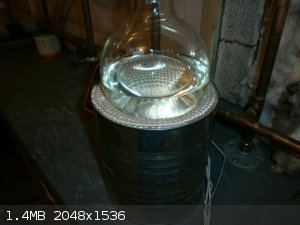 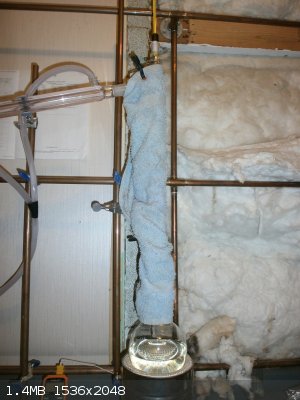 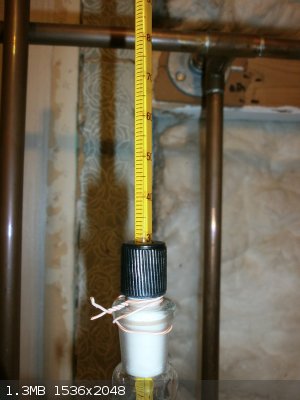
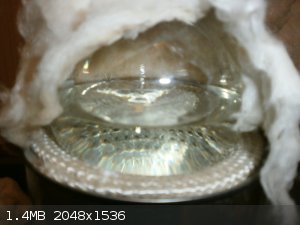
|
|
|
SWIM
National Hazard
   
Posts: 970
Registered: 3-9-2017
Member Is Offline
|
|
What sort of yield do you get per gallon of starting material?
|
|
|
XeonTheMGPony
International Hazard
    
Posts: 1641
Registered: 5-1-2016
Member Is Offline
Mood: No Mood
|
|
for 500 ml you'll get just under 250ml worth of 20c - 61c fraction
then when you make your boiling point cuts it varies, colder the condenser the better recovery.
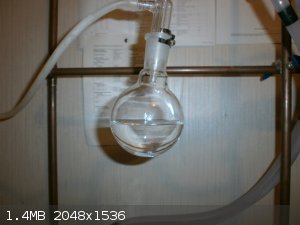
|
|
|
Deathunter88
National Hazard
   
Posts: 570
Registered: 20-2-2015
Location: Beijing, China
Member Is Offline
Mood: No Mood
|
|
Keep in mind that petroleum ether is mostly saturated alkanes, whilst gasoline is full of unsaturated olefins/alkenes, making it much more reactive.
The petroleum ether you get from gasoline will likely not be suitable anytime it will contact strong acids, bases etc, but it still might be OK for
cleaning grease, as a paint thinner, or a clean fuel.
|
|
|
unionised
International Hazard
    
Posts: 5142
Registered: 1-11-2003
Location: UK
Member Is Offline
Mood: No Mood
|
|
Or you can buy light naphtha as lighter fluid.
https://en.wikipedia.org/wiki/Lighter_fluid
Doesn't really need distilling except to strip out any garbage it picked up along the way.
Largely saturated hydrocarbons (because crude oil is largely saturated).
|
|
|